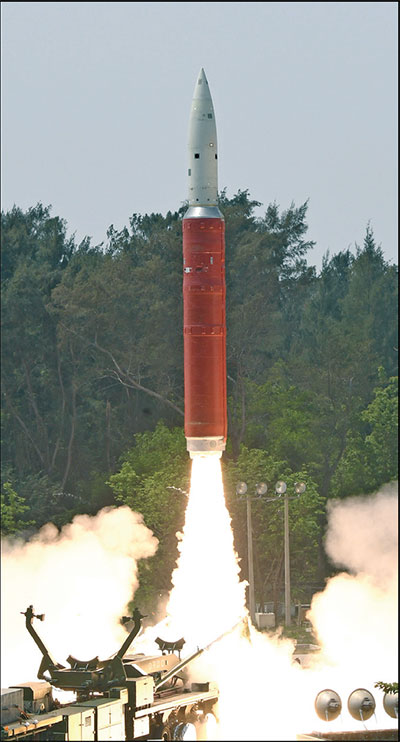India is finally focusing on space warfare
Yunus Dar
India has lately been giving increased importance to space assets. With the Anti-Satellite (ASAT) test on 27 March 2019, Prime Minister Narendra Modi stunned the global powers with his announcement that India had become the fourth country to conduct an ASAT missile test. Space has been the exclusive domain of great powers, such as the US and Russia, since decades, which is now rapidly changing.

Back in 2008, government of India announced its plans to create an Integrated Space Cell, which is jointly operated by the three-armed forces – army, navy and air force — besides the Defence Research and Development Organisation (DRDO) and Indian Space Research Organisation (ISRO) itself, which makes it more of an information network system. The agency was to coordinate and strategise India’s space defence systems, working in collaboration with the defence networks, and develop potential space strategies. While primarily conceptualised for development of civilian programmes, ISRO has, in collaboration with the DRDO, developed several dual uses as well as purely military satellites for the armed forces. There are more than 320 military satellites orbiting the earth currently, with the US owning almost half of them, followed by China and Russia. India lags behind in terms of military-only satellites, however, the pace is now quickening with ISRO developing its own heavy launch systems.
India’s push for self-reliance in navigation led to the creation of Indian Regional Navigation Spacecraft System (IRNSS), which envisages establishment of regional navigation system using a combination of Geostationary Earth Orbit (GEO) and Geosynchronous Orbit (GSO) spacecraft. The series of IRNSS satellites provided game-changing solutions for civilians as well as strategic applications. India launched its first exclusive satellite for the military called, GSAT-7, in August 2013 from Kourou spaceport in French Guiana, on European space consortium Arianespace’s Ariane 5 rocket. The multi-band home-built communication spacecraft was dedicated to the Indian Navy for use in maritime security, helping space-based marine communications.
The country launched its second strategic use satellite, GSAT-6, in August 2015 using the GSLV, when it gained the capability to launch heavy satellites to geostationary orbits for the first time. In March 2018, it launched GSAT-6A, which is again a high power S-band communication satellite with military applications. Then there is the Cartosat series of satellites, which have been providing high-resolution scene-specific spot imagery in various scales. The all-weather RISAT-2 spy satellite, launched in 2009, added more teeth to the Indian armed forces in radar imaging and mapping besides other applications. The GSAT-7A advanced military satellite, dedicated to the Indian Air Force (IAF), was launched in December 2018. GSAT-7A is being primarily used to guide military unmanned aerial vehicles (UAVs), shifting the monitoring of drones from ground-based to space-based control.
India has been steadily increasing its presence in space with new military satellites. The successful ASAT test in March this year give a significant flip to its capabilities in space. In June 2019, the Cabinet Committee on Security headed by Prime Minister Narendra Modi approved creation of the Defence Space Research Agency (DSRO), which will oversee India’s space operations and help space warfare weapon systems. The scientists in this new agency will collaborate with all the three services, while also providing the research and development support to the Defence Space Agency (DSA), which was created to help the country fight wars in the space. According to the government, DSA will be based in Bengaluru and is likely to be headed by an Air Vice Marshal-rank officer.
So, what is the Indian strategy when it comes to space operations? What could be the implications of space conflict? Air Vice Marshal Kapil Kak (retd) spoke to FORCE about the significance of this new form of warfare. He said, “the crucial point at this juncture is whether we can secure our satellites in space against efforts by our adversary through ‘hard-kill’ and ‘soft-kill’ option. ‘Hard-kill’ is problematic because of space debris and our satellite engagement through demonstration of ballistic missile defence as I understand is that element of debris is still there. This effects all. How do you manage the debris? So, there is a certain level of international understanding that space, even when it’s weaponised, the question of debris must not assume large-scale concerns because it effects every single country in the world.”
On being asked whether India has a long way to go before it can establish a significant presence in space, he said it’s all related to what’s your resource, and larger resource, and how do you intend to spend that resource in inter-sectoral prioritisation. If India tomorrow decides that it will have an overarching military space capabilities, it’s not a problem area. It can go in that direction. We do not now have any dependence on technological inflows from advanced countries. We have much advanced capabilities with us.
At a time when the armed forces are lamenting the lack of funds for modernisation efforts, is it feasible to invest so much in a domain like space? How do we prioritise the resource allocation? Air Vice Marshal Kapil Kak (retd) said we have on the one hand very sharp reduction in numbers of the combat squadrons of the air force. “You are aware that we are now down to 30 squadrons, instead of 42 squadrons, so some money must go there. We also have problem, for example, in the army and the navy. The submarines in the navy is a big problem. Likewise, the army’s basic infantry systems, utility helicopters, etc. So, it’s a matter of prioritisation. It’s also important to note that we are not competing with advanced nations. It’s a need-based, issue-based, function-specific prioritisation depending on what your threats are and how do you meet these threats through inter-sectoral allocation of resources – financial, human, technological and everywhere else. So, in my understanding of our current space capabilities, I do believe we are doing reasonably well to meet our challenge metrics.”
You must be logged in to view this content.

